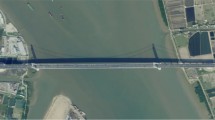Abstract
The extreme temperature differences in flat steel box girder of a cable-stayed bridge were studied. Firstly, by using the long-term measurement data collected by the structural health monitoring system installed on the Runyang Cable-stayed Bridge, the daily variations as well as seasonal ones of measured temperature differences in the box girder cross-section area were summarized. The probability distribution models of temperature differences were further established and the extreme temperature differences were estimated with a return period of 100 years. Finally, the temperature difference models in cross-section area were proposed for bridge thermal design. The results show that horizontal temperature differences in top plate and vertical temperature differences between top plate and bottom plate are considerable. All the positive and negative temperature differences can be described by the weighted sum of two Weibull distributions. The maximum positive and negative horizontal temperature differences in top plate are 10.30 °C and −13.80 °C, respectively. And the maximum positive and negative vertical temperature differences between top plate and bottom plate are 17.30 °C and −3.70 °C, respectively. For bridge thermal design, there are two vertical temperature difference models between top plate and bottom plate, and six horizontal temperature difference models in top plate.
Similar content being viewed by others
References
WILLIAM G W, SHOUKRY S N, RIAD M Y. Study of thermal stresses in skewed integral abutment steel girder bridges [J]. Structural Engineering International, 2012, 22(3): 308–317.
SUBRAMANIAM K V, KUNIN J, CURTIS R, STREETER D. Influence of early temperature rise on movements and stress development in concrete decks [J]. Journal of Bridge Engineering, 2010, 15(1): 108–116.
TONG M, THAM L G, AU F T K, LEE P K K. Numerical modelling for temperature distribution in steel bridges [J]. Computers and Structures, 2001, 79(6): 583–593.
SONG Z W, XIAO J Z, SHEN L M. On temperature gradients in high-performance concrete box girder under solar radiation [J]. Advances in Structural Engineering, 2012, 15(3): 399–415.
LARSSON O, KAROUMI R. Modelling of climatic thermal actions in hollow concrete box cross-sections [J]. Structural Engineering International, 2011, 21(1): 74–79.
KENNEDY J B, SOLIMAN M H. Temperature distribution in composite bridges [J]. Journal of Structural Engineering-ASCE, 1987, 113(3): 475–482.
LIU H B, CHEN Z H, ZHOU T. Theoretical and experimental study on the temperature distribution of H-shaped steel members under solar radiation [J]. Applied Thermal Engineering, 2012, 37: 329–335.
CAO Y H, YIM J, ZHAO Y, WANG M L. Temperature effects on cable stayed bridge using health monitoring system: A case study [J]. Structural Health Monitoring-An International Journal, 2011, 10(5): 523–537.
ROBERTS-WOLLMAN C L, BREEN J E, CAWRSE J. Measurements of thermal gradients and their effects on segmental concrete bridge [J]. Journal of Bridge Engineering, 2002, 7(3): 166–174.
XU Y L, CHEN B, NG C L, WONG K Y, CHAN W Y. Monitoring temperature effect on a long suspension bridge [J]. Structural Control & Health Monitoring, 2010, 17(6): 632–653.
XIA Y, HAO H, ZANARDO G, DEEKS A. Long term vibration monitoring of a RC slab: Temperature and humidity effect [J]. Engineering Structures 2006, 28(3): 441–452.
KULLAA J. Eliminating environmental or operational influences in structural health monitoring using the missing data analysis [J]. Journal of Intelligent Material Systems and Structures, 2009, 20(11): 1381–1390.
KULLAA J. Distinguishing between sensor fault, structural damage, and environmental or operational effects in structural health monitoring [J]. Mechanical Systems and Signal Processing, 2011, 25(8): 2976–2989.
DING Y L, LI A Q. Temperature-induced variations of measured modal frequencies of steel box girder for a long-span suspension bridge [J]. International Journal of Steel Structures, 2011, 11(2): 145–155.
DENG Y, DING Y L, LI A Q. Fatigue reliability assessment for bridge welded details using long-term monitoring data [J]. Science China-Technological Sciences, 2011, 54(12): 3371–3381.
LEE J H. Investigation of extreme environmental conditions and design thermal gradients during construction for prestressed concrete bridge girders [J]. Journal of Bridge Engineering, 2012, 17(3): 547–556.
CASTILLO E, HADI A S, BALAKRISHNAN N, SARABIA J M. Extreme value and related models with applications in engineering and science [M]. New Jersey: John Wiley & Sons, Inc., 2005: 248.
Eurocode 1: Actions on structures (BS EN 1991-1-5: 2003) [S]. Standards Policy and Strategy Committee, 2004: 31.
Author information
Authors and Affiliations
Corresponding author
Additional information
Foundation item: Project(51178100) supported by the National Natural Science Foundation of China; Project(1105007001) supported by the Foundation of the Priority Academic Development Program of Higher Education Institute of Jiangsu Province, China; Project(3205001205) supported by the Teaching and Research Foundation for Excellent Young Teachers of Southeast University, China
Rights and permissions
About this article
Cite this article
Ding, Yl., Wang, Gx. Estimating extreme temperature differences in steel box girder using long-term measurement data. J. Cent. South Univ. 20, 2537–2545 (2013). https://doi.org/10.1007/s11771-013-1766-6
Received:
Accepted:
Published:
Issue Date:
DOI: https://doi.org/10.1007/s11771-013-1766-6



